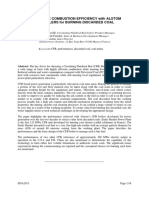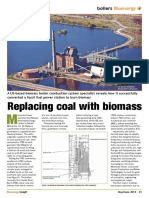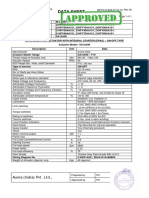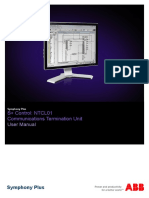2 2a2 PDF
2 2a2 PDF
Uploaded by
anbarasanCopyright:
Available Formats
2 2a2 PDF
2 2a2 PDF
Uploaded by
anbarasanOriginal Title
Copyright
Available Formats
Share this document
Did you find this document useful?
Is this content inappropriate?
Copyright:
Available Formats
2 2a2 PDF
2 2a2 PDF
Uploaded by
anbarasanCopyright:
Available Formats
Part 2 CCT Overview
Coal-fired Power Generation Technologies (Combustion Technologies)
2A2. Circulating Fluidized-bed Combustion Technology (CFBC)
Technology Overview
1. Features
The features of circulating fluidized-bed boilers are described thermal NOx emissions as the generation of NOx is dependent
below. upon the combustion temperature. In addition, the operation of
1) Compatibility with wide range of fuels circulating fluidized-bed boilers involves a two-stage combustion
Conventional boilers for power generation can use only fossil process: the reducing combustion at the fluidized-bed section,
fuels, such as high-grade coal, oil, and gas. The CFBC is also and the oxidizing combustion at the freeboard section. Next, the
capable of using low-grade coal, biomass, sludge, waste plastics, unburned carbon is collected by a high-temperature cyclone
and waste tires as fuel. located at the boiler exit to recycle to the boiler, thus increasing
2) Low polluting the denitration efficiency.
NOx and SOx emissions are significantly decreased without 3) High combustion efficiency
special environmental modifications. In the case of fluidized-bed Improved combustion efficiency is attained through the use of a
boilers, desulfurization is carried out intrafurnace, using mainly circulating fluidization-mode combustion mechanism.
limestone as the fluidizing material. For denitration, PC boilers 4) Space-saving, ease of maintenance
operate at combustion temperatures from 1,400oC to 1,500oC, Space saving is attained because there is no need for separate
whereas circulating fluidized-bed boilers operate at lower desulfurization, denitration, and fine-fuel crushing units. Accordingly,
temperatures, ranging from 850oC to 900oC, thereby suppressing trouble-spots are minimized, and maintenance is simplified.
2. Technology overview
Figure 1 shows a typical CFBC process flow. Hot cyclone CFBC boiler
Generated steam
Coal Limestone
Flue gas
Boiler feed water Boiler feed water heater
Secondary air
Cyclone Primary air
Circulating Air pre-heater
fluidized-bed Electric
furnace precipitator
Heat ID fan
recovery Stack
section
Ash storage tank
Fig. 1 Process flow of circulating fluidized-bed boiler
Figure 2 provides a rough overview of CFBC. Generally, CFBC
Fig. 2 Schematic drawing of CFBC
consists of a boiler and a high-temperature cyclone. The intra-furnace
gas velocity is as high as 4 to 8 m/s. A coarse fluidizing medium and a pre-heater for the fluidizing air and combustion air, and a boiler feed
char in the flue gas are collected by the high-temperature cyclone water heater, are installed. Most of the boiler technologies are
and recycled to the boiler. Recycling maintains the bed height and manufactured overseas, mainly from Foster Wheeler, Lurgi,
increases the denitration efficiency. To increase the thermal efficiency, Steinmuller, ALSTOM, and Babcock & Wilcox.
3. Study site and application field
Photo 1 shows an overview of a CFBC boiler facility. The CFBC gained refinery (300 t/hr), and Ube Industries, Ltd.s Isa
popularity mainly as a coal-fired boiler. Recently, however, CFBC plant (210 t/hr). An example of an RDF-fired
boilers using RDF and wood-based biomass as the fuel have drawn boiler is Sanix Inc.s Tomakomai plant. The
attention. Typical applications of coal-fired biogas are the Kuraray Co., biomass fuel is mixed with coal and combusted,
Ltd.s Tamashima plant (70 t/hr), Idemitsu Kosan Co., Ltd.s Chiba oil thereby decreasing CO2 emissions.
4. Study period
Most of the circulating, atmospheric-pressure fluidized-bed boiler
(CFBC) technologies were introduced into Japan from abroad,
beginning around 1986. Photo 1 CFBC appearance
5. Progress and development results
CFBC technology was introduced from abroad and used in coal- Outstanding CFBC-related issues include the further
fired boilers. It is used by power producers, iron makers, paper investigation of and efforts to reduce the initial costs and to
producers, and in other sectors. Plans exist to distribute CFBC improve the power generation efficiency for boilers using fuels
technology to China under the Green Aid Plan (GAP). such as RDF, industrial waste, and wood-based biomass.
25
You might also like
- 2VAA001712 en S Control NTCF 21-22-23 - InFI-NET Fiber Optic Termination UnitsDocument73 pages2VAA001712 en S Control NTCF 21-22-23 - InFI-NET Fiber Optic Termination Unitsanbarasan100% (1)
- 1A2. Circulating Fluidized Bed Combustion Technology (CFBC)Document1 page1A2. Circulating Fluidized Bed Combustion Technology (CFBC)kumarmm1234No ratings yet
- 2A2. Circulating Fluidized-Bed Combustion Technology (CFBC)Document1 page2A2. Circulating Fluidized-Bed Combustion Technology (CFBC)Deepak JhaNo ratings yet
- Fluidized Bed BoilerDocument4 pagesFluidized Bed BoilerbobyNo ratings yet
- Study of Circulating Coal Fluidized BoilersDocument5 pagesStudy of Circulating Coal Fluidized BoilersSwaraj BiswasNo ratings yet
- Kiln Burning Systems: Raw Mill From Storage Feed RateDocument43 pagesKiln Burning Systems: Raw Mill From Storage Feed RateMuhammad Kureshi100% (1)
- CFBC BoilersDocument11 pagesCFBC BoilersManoj DesaiNo ratings yet
- B&W FBC Boiler Opeating Experience With U BeamsDocument9 pagesB&W FBC Boiler Opeating Experience With U BeamsNath BoyapatiNo ratings yet
- Boiler OverviewDocument44 pagesBoiler OverviewRopafadzo ChihuriNo ratings yet
- Top-down commercial Evaluation of CFBDocument9 pagesTop-down commercial Evaluation of CFBLevanhuongNo ratings yet
- 1.2 Layout of Modern Coal Power Plant, Super Critical Boilers, FBC Boilers, Steam and Heating RatesDocument32 pages1.2 Layout of Modern Coal Power Plant, Super Critical Boilers, FBC Boilers, Steam and Heating Rateskarthikeyan SNo ratings yet
- Alstom BFB PDFDocument18 pagesAlstom BFB PDFNaveed RabbaniNo ratings yet
- Boiler Circulation 2Document20 pagesBoiler Circulation 2Siva SubramaniyanNo ratings yet
- Fluidized bed combustion - Wikipedia, the free encyclopediaDocument3 pagesFluidized bed combustion - Wikipedia, the free encyclopediaer.rkc91No ratings yet
- Saving of Coke Oven Gas by Reduction of Smoke Pushing of Recovery Type Coke PlantDocument7 pagesSaving of Coke Oven Gas by Reduction of Smoke Pushing of Recovery Type Coke PlantPriyatam KumarNo ratings yet
- High-Temperature and Low-Oxygen Combustion Technology For Carbon Rotary KilnsDocument5 pagesHigh-Temperature and Low-Oxygen Combustion Technology For Carbon Rotary KilnsGauranka MoranNo ratings yet
- Unit 1 Boiler and Boiler PerformanceDocument66 pagesUnit 1 Boiler and Boiler PerformanceBaliKa BakraNo ratings yet
- JPME - Volume 25 - Issue 2 - Pages 45-62Document18 pagesJPME - Volume 25 - Issue 2 - Pages 45-62Maxim VolkovNo ratings yet
- Boiler and Boiler PerformanceDocument64 pagesBoiler and Boiler PerformanceDipti PatilNo ratings yet
- Refractory Failure Investigation in CFBC BoilerDocument9 pagesRefractory Failure Investigation in CFBC BoilerchoksNo ratings yet
- TP CFB 12 03Document16 pagesTP CFB 12 03Harish MechNo ratings yet
- TP CFB 12 03 PDFDocument16 pagesTP CFB 12 03 PDFKim Howard CastilloNo ratings yet
- Application of CFB (Circulating Fluidized Bed)Document6 pagesApplication of CFB (Circulating Fluidized Bed)jomolt41559No ratings yet
- Babcock and Wilcox Boiler.Document9 pagesBabcock and Wilcox Boiler.Sajid RazaNo ratings yet
- BR-1618 Design Consideration BoilerDocument10 pagesBR-1618 Design Consideration Boilertovi hardantoNo ratings yet
- What Are The Main Characteristics of Fluidised Bed Combustors?Document6 pagesWhat Are The Main Characteristics of Fluidised Bed Combustors?NAITIKNo ratings yet
- Boilers and ThermicFluidHeatersDocument42 pagesBoilers and ThermicFluidHeatersHolayilNo ratings yet
- Internal Circulation CFB Boiler PDFDocument11 pagesInternal Circulation CFB Boiler PDFAkhilesh Kumar0% (1)
- IR-CFB Boilers: Supercritical Once-Through Developments For Power GenerationDocument11 pagesIR-CFB Boilers: Supercritical Once-Through Developments For Power Generationömür arasNo ratings yet
- Article From Coal To Biomass at MN PowerDocument3 pagesArticle From Coal To Biomass at MN PowerCory LukerNo ratings yet
- CFBC & PFBC Technology PSJalkote EA 0366Document18 pagesCFBC & PFBC Technology PSJalkote EA 0366Jessica SimpsonNo ratings yet
- CFBC & PFBC TechnologyDocument18 pagesCFBC & PFBC TechnologyomiitgNo ratings yet
- Chapter 1Document6 pagesChapter 1Marvin E. VillanuevaNo ratings yet
- Biomass in BoilerDocument13 pagesBiomass in Boilermbkluimp100% (2)
- Delayed Coking LUMMUSDocument7 pagesDelayed Coking LUMMUSEmad ElgebesyNo ratings yet
- Waste CFB CombustionDocument15 pagesWaste CFB CombustionmihugirNo ratings yet
- CDQ in Coke Plants RINL ADocument13 pagesCDQ in Coke Plants RINL AishaNo ratings yet
- (PDF) CFB Refractory RepairDocument1 page(PDF) CFB Refractory RepairManuel CampuzanoNo ratings yet
- 3a36ced49c43ba73e9d1a3f9038c41fdDocument6 pages3a36ced49c43ba73e9d1a3f9038c41fdNguyen Thanh TrungNo ratings yet
- Boilers - An OverviewDocument22 pagesBoilers - An OverviewjsnathNo ratings yet
- CFBC Boiler - A SurveyDocument11 pagesCFBC Boiler - A SurveygjanklesariaNo ratings yet
- Advances in Delayed Coking Heat Transfer EquipmentDocument6 pagesAdvances in Delayed Coking Heat Transfer EquipmentBahar MeschiNo ratings yet
- CF BC Boiler Refractory Selection Design and InstallationDocument10 pagesCF BC Boiler Refractory Selection Design and Installationaref zandNo ratings yet
- Energy Conservation Oppurtunities in Boiler SystemDocument34 pagesEnergy Conservation Oppurtunities in Boiler SystemSiddharth Jain67% (3)
- Coal-Fired Thermal Power PlantDocument157 pagesCoal-Fired Thermal Power PlantJonas PadillaNo ratings yet
- Different Types of Boilers 1721585709Document42 pagesDifferent Types of Boilers 1721585709asd141986No ratings yet
- S K HazraDocument6 pagesS K HazraRicky MenonNo ratings yet
- Delayed Coker OptimizationDocument18 pagesDelayed Coker OptimizationshahabmatajiNo ratings yet
- Combustion+CharacterizationDocument7 pagesCombustion+CharacterizationvelmuruganNo ratings yet
- Suspension (PC) Combustion: Chungen YinDocument47 pagesSuspension (PC) Combustion: Chungen YinAakash Ranjan100% (1)
- FLUID COKING™ Conversion Technology: Upgrading Heavy Hydrocar-Bons With Effi - Cient Integration For Power/steamDocument2 pagesFLUID COKING™ Conversion Technology: Upgrading Heavy Hydrocar-Bons With Effi - Cient Integration For Power/steamAbizer JamaliNo ratings yet
- Encyclopaedia Britannica, 11th Edition, Volume 8, Slice 3 "Destructors" to "Diameter"From EverandEncyclopaedia Britannica, 11th Edition, Volume 8, Slice 3 "Destructors" to "Diameter"No ratings yet
- Process Steam Systems: A Practical Guide for Operators, Maintainers, and DesignersFrom EverandProcess Steam Systems: A Practical Guide for Operators, Maintainers, and DesignersNo ratings yet
- Sustainable Energy Conversion for Electricity and Coproducts: Principles, Technologies, and EquipmentFrom EverandSustainable Energy Conversion for Electricity and Coproducts: Principles, Technologies, and EquipmentNo ratings yet
- Geothermal Energy: Sustainable Heating and Cooling Using the GroundFrom EverandGeothermal Energy: Sustainable Heating and Cooling Using the GroundNo ratings yet
- Synthetic Natural Gas: From Coal, Dry Biomass, and Power-to-Gas ApplicationsFrom EverandSynthetic Natural Gas: From Coal, Dry Biomass, and Power-to-Gas ApplicationsTilman J. SchildhauerNo ratings yet
- Mechanics of the Household: A Course of Study Devoted to Domestic Machinery and Household Mechanical AppliancesFrom EverandMechanics of the Household: A Course of Study Devoted to Domestic Machinery and Household Mechanical AppliancesNo ratings yet
- 3.BOQ - As Per Module Loading DiagramDocument19 pages3.BOQ - As Per Module Loading DiagramanbarasanNo ratings yet
- 14 3Document2 pages14 3anbarasanNo ratings yet
- 17 MEPL DCS CLCS Logic Co Ordinated ControlDocument2 pages17 MEPL DCS CLCS Logic Co Ordinated ControlanbarasanNo ratings yet
- 13Document9 pages13anbarasanNo ratings yet
- Instruction For Shaft Jacking Device 141A.553SM (B) - 5Document16 pagesInstruction For Shaft Jacking Device 141A.553SM (B) - 5anbarasanNo ratings yet
- SA12A90 - F10 Data Sheet On-OffDocument1 pageSA12A90 - F10 Data Sheet On-Offanbarasan100% (1)
- Lube Oil System Instruction 141A.000.2SM (B) - 5Document32 pagesLube Oil System Instruction 141A.000.2SM (B) - 5anbarasan50% (2)
- Re - (Foxboro) Fbm222 Comm Overrun - Foxboro - FreeListsDocument3 pagesRe - (Foxboro) Fbm222 Comm Overrun - Foxboro - FreeListsanbarasanNo ratings yet
- 2VAA001654 - en S Control SPDSM04 Pulse Input ModuleDocument49 pages2VAA001654 - en S Control SPDSM04 Pulse Input ModuleanbarasanNo ratings yet
- 9akk101130d1385 - PGP API ManualDocument193 pages9akk101130d1385 - PGP API ManualanbarasanNo ratings yet
- 9AKK101130D1384 - PGPdisplayBuilder ManualDocument271 pages9AKK101130D1384 - PGPdisplayBuilder ManualanbarasanNo ratings yet
- 2VAA001695 en S Control NTCS04 Controller Station Termination UnitDocument43 pages2VAA001695 en S Control NTCS04 Controller Station Termination UnitanbarasanNo ratings yet
- 2VAA001664 en S Control NTCL01 Communications Termination UnitDocument39 pages2VAA001664 en S Control NTCL01 Communications Termination UnitanbarasanNo ratings yet
- 2VAA001694 - en S Control NTDO02 Digital Output Termination UnitDocument41 pages2VAA001694 - en S Control NTDO02 Digital Output Termination UnitanbarasanNo ratings yet
- 2VAA001694 - en S Control NTDO02 Digital Output Termination UnitDocument41 pages2VAA001694 - en S Control NTDO02 Digital Output Termination UnitanbarasanNo ratings yet
- 2VAA001693 en S Control NTDI01 Digital IO Termination UnitDocument35 pages2VAA001693 en S Control NTDI01 Digital IO Termination Unitanbarasan0% (1)
- 2VAA001695 en S Control NTCS04 Controller Station Termination UnitDocument43 pages2VAA001695 en S Control NTCS04 Controller Station Termination UnitanbarasanNo ratings yet
- 2VAA001711 - en S Control SPCPM02 Communication Port ModuleDocument63 pages2VAA001711 - en S Control SPCPM02 Communication Port ModuleanbarasanNo ratings yet
- 2VAA001711 - en S Control SPCPM02 Communication Port ModuleDocument63 pages2VAA001711 - en S Control SPCPM02 Communication Port ModuleanbarasanNo ratings yet












































































